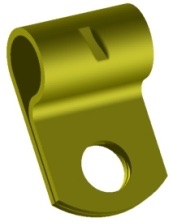Page 1 of 1
Carb Heat Cable Slipping
Posted: Mon Nov 26, 2018 7:45 pm
by cessna170bdriver
Lately I've noticed a different "feel" to the carb heat control, inconsistent RPM drops when checking it at runup, and sometimes less than expected RPM in cruise. Upon removing the cowling and checking the control, I notice that the cable will slip in the clamp at the carb heat box with only a moderate tug. From the photo, you'll see that the clamp is the MS21919 cushioned type, and appears to be a -3, or nominally 3/16 inch.
Can I:
(a) just put a short length of heat shrink tubing over the cable to make the clamp grip better?
(b) use an uncushioned AN742-3 clamp? (what the IPC seems to show, although the part number in the IPC is obsolete)
(c) go to a smaller -2 clamp of either the cushioned or uncushioned variety? (The cable ID measures 0.190, which is smaller than the maximum allowable ID of either variety of clamp).
Re: Carb Heat Cable Slipping
Posted: Mon Nov 26, 2018 9:51 pm
by n2582d
Miles,
The '75-'86 C-172 IPC calls for a S2226-2 clamp there. It seems to me though that it should be a S2226-3 given the outer diameter of the cable is 0.190". The dash number is size in 16ths of an inch. Here's a picture of S2226-3 clamps.

- S2226-3 clamps
- s-l300.jpg (17.72 KiB) Viewed 22654 times
McFarlane sells a similar clamp, 6317-3, as pictured here:

- Clamp.jpg (13.75 KiB) Viewed 22654 times
As you can see both have detents to help secure the cable. Alternatively, I've seen an MS21919 clamp like you have wrapped with a couple of turns of safety wire to secure the cable.
Re: Carb Heat Cable Slipping
Posted: Tue Nov 27, 2018 9:36 am
by GAHorn
As is often the case, Gary has the good answer. The "tooth" in the 6317 accommodates/mates with the spiral O.D. of the Bowden cable and holds it securely. This is a great illustration of how incorrect parts can "slip" into repair schemes without being obvious.
Re: Carb Heat Cable Slipping
Posted: Wed Nov 28, 2018 4:28 am
by cessna170bdriver
Thank you Gary. I like the McFarlane camp and will order a 4-pack (the minimum quantity). If anyone else wants/needs one, I’ll be happy to share the excess.
Re: Carb Heat Cable Slipping
Posted: Thu Nov 29, 2018 6:23 am
by n2582d
Glad to help Miles. Might be worth hanging onto your spare clamps to use on the mixture control cable and/or cabin vent cable.
Re: Carb Heat Cable Slipping
Posted: Wed Dec 05, 2018 3:16 pm
by cessna170bdriver
Works much better now! I probably should replace that clamp on the mixture control cable as well, even though it’s working fine at the moment.
Re: Carb Heat Cable Slipping
Posted: Wed Dec 05, 2018 3:44 pm
by n2582d
Looks good Miles.
Dynamic Propeller has a picture of what I mentioned regarding using safety wire to lock the cable to a clamp.
They sell a clever end fitting for bowden cables. Not approved for the C-170 but seems like minor alteration to me. About $30 overpriced.
Re: Carb Heat Cable Slipping
Posted: Thu Dec 06, 2018 2:40 am
by johneeb
Re: Carb Heat Cable Slipping
Posted: Thu Dec 06, 2018 7:12 pm
by cessna170bdriver
John, notice that there’s no oil INSIDE the quick drain. I believe that drip is running down from the oil filter adapter...

Re: Carb Heat Cable Slipping
Posted: Fri Dec 07, 2018 7:25 pm
by GAHorn
Johns comment regarding quick-drains has value to anyone having such. There have been numerous instances (mostly nose-wheel aircraft) which have had their quick-drains opened in flight because they were bumped by equipment in the cowling. Other failures have included failed O-rings inside the valve. A "cork" is not a solution I've heard of until now... but I can imagine a short piece of closed-ended-hose clamped onto the nozzle/barb or perhaps some other imaginative method.
But the most common failure of these things have been those that have a length of open drain-hose permanently left in-situ on the nozzle/barb, and that hose becomes the method or object that is bumped and which opens the valve. Not a nice thing to see your oil pressure reading "0" in-flight with the RPM running slow being your first clue.

I have a boat which has a quick-drain and I've insured it by permanently clamping a drain-hose to it... the opposite end of the drain hose has a male brass nipple and a brass cap (NPT threads) on it. In order to drain the oil, I first pull the hose-end with the cap out the bilge-drain beneath the transom and remove the cap with the hose-end over a catch-bucket. I then activate the quick-drain to let the oil out. This might be an adaptable idea... YMMV.